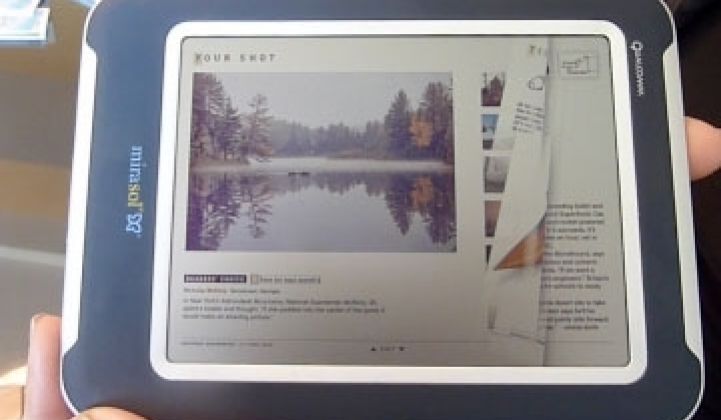It's taken nearly two decades, but a technology that is getting quite close to electronic paper will soon hit the market.
Qualcomm late this year will begin to produce Mirasol displays -- thin, energy-efficient displays that show video and reproduce color accurately -- and ship them to consumer electronics manufacturers. By the first quarter, expect to see e-readers containing the 5.7-inch screens. See a prototype in the photo.
2011 will also likely see the debut of thin, energy-efficient color screens from Prime View International, which bought E-Ink last year. The Liquavista screen from Philips may also appear in products by then. LG Display is also working on a version of color paper, according to research firm DisplaySearch.
What's the big deal? Consumers are now watching video and playing games on their smart phones and tablets. That sucks battery life. Batteries improve in performance very gradually and they weigh a lot. Thus, manufacturers and consumers are faced with a trade-off between functionality and mass. To get to that futuristic world where we can replace paper with electronics and reap the benefits in recycling and energy efficiency (i.e., reducing pulp processing), the screen has to change.
These displays help crack that problem because they use far less power than an LCD. The Mirasol displays, for instance, do not need internal light bulbs like LCDs. Instead, Mirasol relies on reflected, ambient light. The images are created by a MEMS -- a microelectromechanical device, or a microscopic machine -- that moves pixels back and forth to create red, green or blue. The principles behind the screen derive from how humans perceive the bright colors on butterfly wings.
An e-book containing a Mirasol screen will last three times to five times as long on a battery charge than a typical e-book, says director of marketing Cheryl Goodman. A screen sized for phones will come out next.
The e-books are also quite thin and functional. Goodman let me play with one. (Video coming soon.) It was light and I couldn't detect "hot spots" on the back surface. More importantly, the video was clear. I even tried it in different conditions -- near the window, under the table, facing away from the window. The image stayed somewhat clean and I didn't get much glare. By contrast, LCDs are notoriously difficult to see outside.
E-Ink screens contain balls that are now painted black on one side and white on the other (the color version will presumably have red, green and blue). When an electric charge passes through, the balls arrange themselves accordingly, sort of like a card section in a stadium. Liquavista (best name, arguably least developed technology) relies on electrowetting, a process based on the fact that water repels oil.
It's been a long road. Both E-Ink, which was soaked in millions in VC funds, and Iridigm Display, which got acquired by Qualcomm in 2004, came out of MIT in the mid '90s. And before the companies were formed, the research had already been taking place. Philips has shown Liquavista prototypes at shows for years.
Qualcomm, by the way, will actually make the Mirasol screen. Usually, Qualcomm just licenses its intellectual property. But with a new product, quality control is key.
I met with Qualcomm at the Emerging Displays Conference in San Jose. Other highlights:
--OLED screens accounted for $900 million in revenue in 2009. By 2018 it should grow to $8 billion, according to DisplaySearch. OLED lighting could grow to $6.2 billion by then.
--Corning is touting a green laser. A green laser is the signature product of Soraa, the Khosla Ventures-backed startup now headed up by former Intel marketing guy Eric Kim. That's a really, really bad sign for Soraa.
--Small projectors weighing less than a pound and curbing power with LED lights will be a big deal. 142 million units will ship in 2018.



